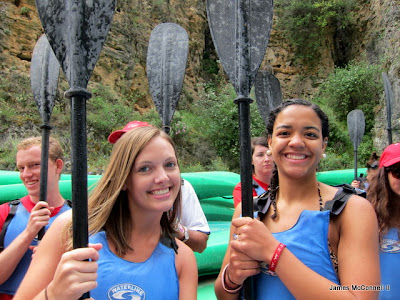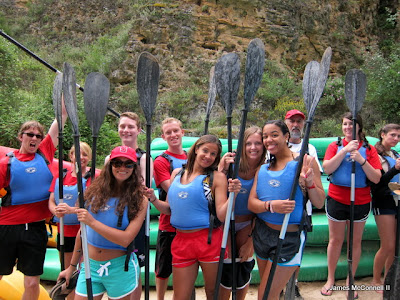Today we took an excursion to Madrid. For this they didn’t let us take photos anywhere so I think that the Internet will suffice as far as images for you.
We took the bus out of Segovia at 9 this morning and arrived at the Palacio Real at 10:30. The Palace is absolutely huge. King Louis XV (son of Louis XIV who is famous for being one of the most brutal leaders in the history of Europe) built the Palace. Just as a side note: Does anyone else notice how interbred the great monarchies of Europe are? Like the King of Spain is the son of the King of France. There are more connections but those are not important. The palace was gigantic. It consisted of more rooms than we could count. We had a really rude tour guide that we all wanted to strangle, but it gave you the “important location” feel that you get around the world. The coolest room that we saw was one where the wall was decorated with porcelain that could be removed for cleaning. This was another reference to how rich these people were. Here is a link to the website for more information and pictures: http://www.patrimonionacional.es/Home/Palacios-Reales/Palacio-Real-de-Madrid.aspx.
We have a quick cultural lesson for you. Inside the palace are statues of lions always in even numbers, symmetric, and with a ball under one paw. Many people do not realize that this is taken from the Chinese, which had established trade with Europe since the Roman Empire through the Silk Road. The thing that is incorrect about these lions is that the one on the left (facing the entrance) is supposed to have a baby under its paw. The globe represents the world and symbolizes power. The baby signifies importance of protection of the young and the future. We think (and this is just my opinion) that this error is a representation of old Europe’s obsession with power and disregard with balance with the world around them, building palaces and castles and cultures in places that they do not belong and disregarding other cultures underlining their ultimate defeat in colonization. Just a thought.
The next part of the day we saw the Museo del Prado of Madrid. Here is a link to their page: http://www.museodelprado.es/en/. The museum is chucked full of paintings bearing immense value, both cultural and monetary. Included are the works of Goya and other great artists.
For lunch were had a delicious stuffed eggplant and fish with a raspberry and cheesecake dessert. Yummers.
After the museum we went to the streets and took to shopping around the city before returning to Segovia. That is all we have today. Look forward to the future!
 |
| Outside of the palace |
 |
Beautiful frescoes decorate the ceiling
|
 |
| Rococo style is prevalent |
 |
| Goya is found in the Prado |
 |
| The museum houses some art from all over the world |
 |
| Statues abound outside as well |
 |
| The fountain of Neptune greets you as you drive to the museum |
Hoy nuestra clase fue en una excursión a Madrid. No pudimos sacar fotos entonces las fotos son del internet.
La clase fue en el autobús de Segovia sobre las nueve en la mañana y nosotros llegamos al Palacio Real. El Palacio es muy grande y El Rey Louis XV construyó El Palacio. Una nota: Sabes que la familia real cruza con su propio familia. Por ejemplo El Rey de España es el hijo del Rey de Francia. Hay más conexiones pero no es importante. El Palacio es enorme. Hay más de 2300 salas entonces no visitamos todas las salas. Tuvimos una guía turística grosera que la clase quería estrangular. La mejor sala en El Palacio es la sala porcelana y la murallas son desmontables entonces las personas pueden limpiar las murallas. La familia podía tener murallas desmontables porque la familia tenía mucho dinero. Este es un enlace para más información y fotos: http://www.patrimonionacional.es/Home/Palacios-Reales/Palacio-Real-de-Madrid.aspx.
Una cosa interesante sobre El Palacio es que hay estatuas de leones y todos son simétricos y tienen un balón debajo de una zarpa. Hay un número par de leones en El Palacio y la idea es de los chinos. Este llevó a fundación de comercio exterior con Europa y China. El balón debajo de la zarpa es un símbolo del mundo y poder. Una cosa incorrecta es el león en la izquierda debe tener un cachorro y el cachorro es un símbolo de protección de el joven y el futuro. Pensamos que este error es porque Europa estaba obsesionado con poder y no importaba sobre con la balanza del mundo. España construía palacios, castillos, y culturas en lugares y no tenia cuidado sobre otras personas ni otras culturas en España.
En la tarde la clase fue Museo del Prado de Madrid. El museo tiene muchas pinturas con valores de cultura y monetario. Pinturas son obras de Goya y otras artistas granes.
Para almuerzo comimos berenjena o salchichas o mariscos con tarta de queso con frambuesas.
Después del almuerzo la clase podía caminar las calles y comprar con otros estudiantes.
























































